Teaching Methods


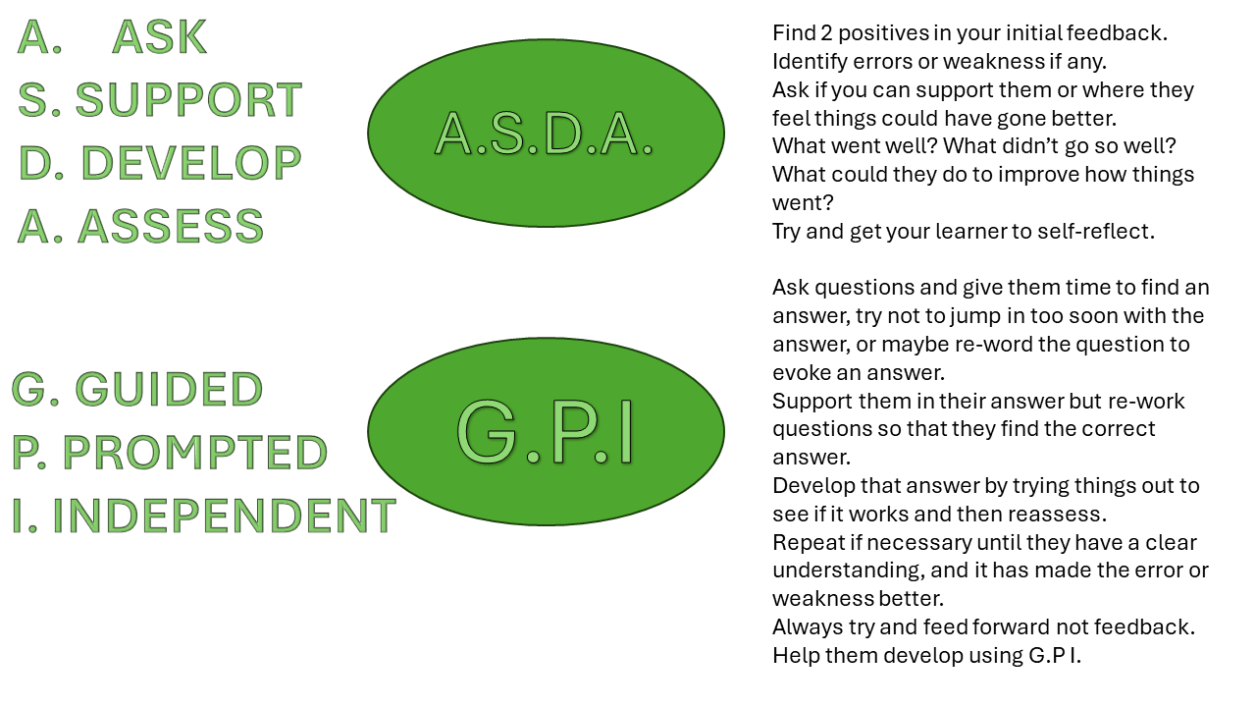
Methods used to develop your pupils understanding and knowledge.
An early days learner may need full guidance on everything they do, as their skills progress they may only need prompting to do certain things, and by the time they have perfected those skills they should be able to carry them out totally independently.

Being able to talk through a subject on our own and being able to say everything about that subject to our client without thinking about it.
We should be able to give a complete talk through while either stationary or on the move so that or pupil can understand and act on our instruction in a timely manner without confusion.
Think about it as you being able to stand in front of a group of people and reading a book to them confidently, or explaining a subject without a book so that they understand it.
You are giving them the "complete" talk through.

Our client may need hints, or prompts to evoke an awareness or to evoke an action from them.
Again this needs to be clear and timely from the instructor without causing confusion.
Think about prompting as someone who might not be able to read and you are helping them to breaking down every little word so that they understand it.

At the stage of full independence the pupil should be able to carry out any instruction without the need for guidance or prompts whatsoever.
Thinking about the book analogy again, when your pupil can read the book themselves without any assistance from you, you know they are carrying this out independently.
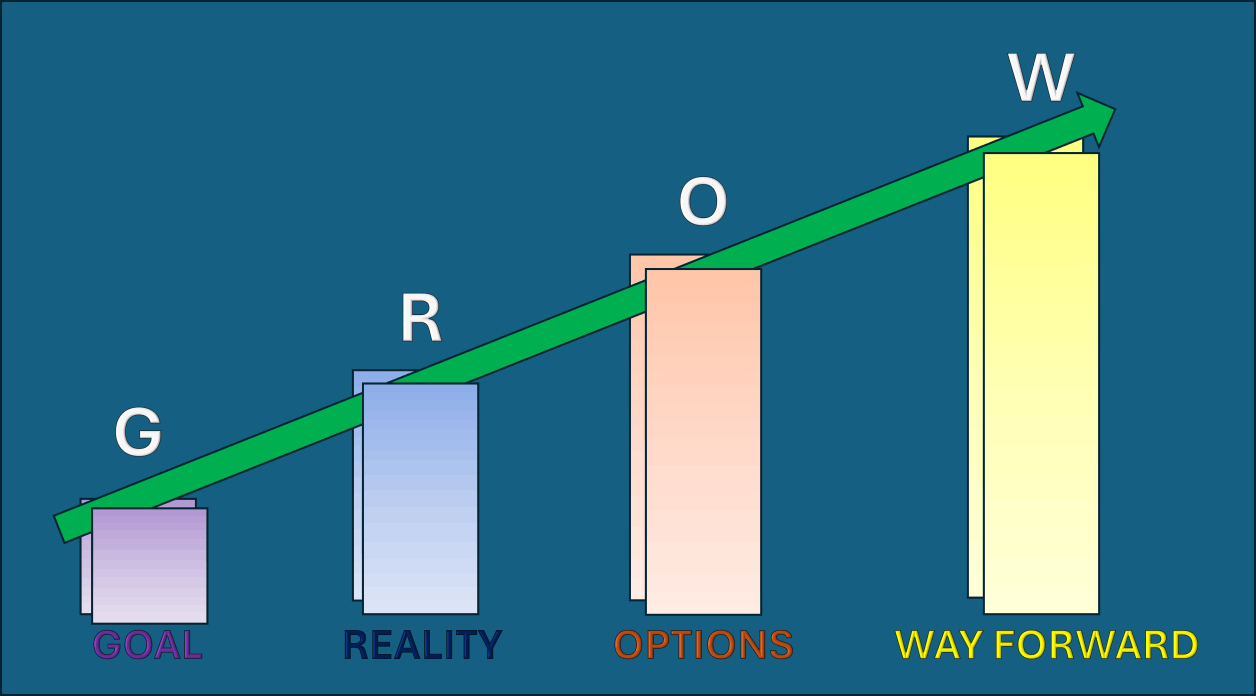
A method that makes sense in just the use of the word GROW.
Lets say your pupil has been making a particular mistake quite regularly.
Your are having a problem trying to sort it out with them.
This is where teaching methods can have a huge benefit for you and your learner.
It may be that you mix up the teaching methods form pupil to pupil until you find one that works for them.
Grow is very simple though.
It allows you to find a goal.
What does you learner need to achieve?
By setting a goal, you both have a target to work towards, but it is about your pupils goal not yours..
Is the goal you've consider really achievable?
If it is, it may have a time constraint needing to be put on it, that it may not be achieved instantly and may even need a few lesson to have achieved it.
So be real with yourself and your pupil, and set a reality check to it.
Things to ask yourself:
Is your pupil at a standard that they should even be considering setting the goal?
Are you rushing things on too quickly and they don't yet have the necessary skills to achieve the goal.
If they have the skills what options do you have to help them achieve that goal. what might they need to do differently to achieve that goal. What could they change to improve things.
Try and encourage your pupil to come up with the ideas of things to adapt or change totally to achieve their goal.
Once this has been discussed, you can now find a way forward and a plan of action to put this to the test and improve things.
Find out what help your pupil needs, if any!Possibly get them to scale their current standard from 1-10 then go out, practice what you've discussed and the rescale at the end. If improvement has been made, by how much? if the score isn't where it needs to be (YOUR PUPILS SCORE NOT YOURS!) then use the GROW method all over again and continue until the skill has been improved.
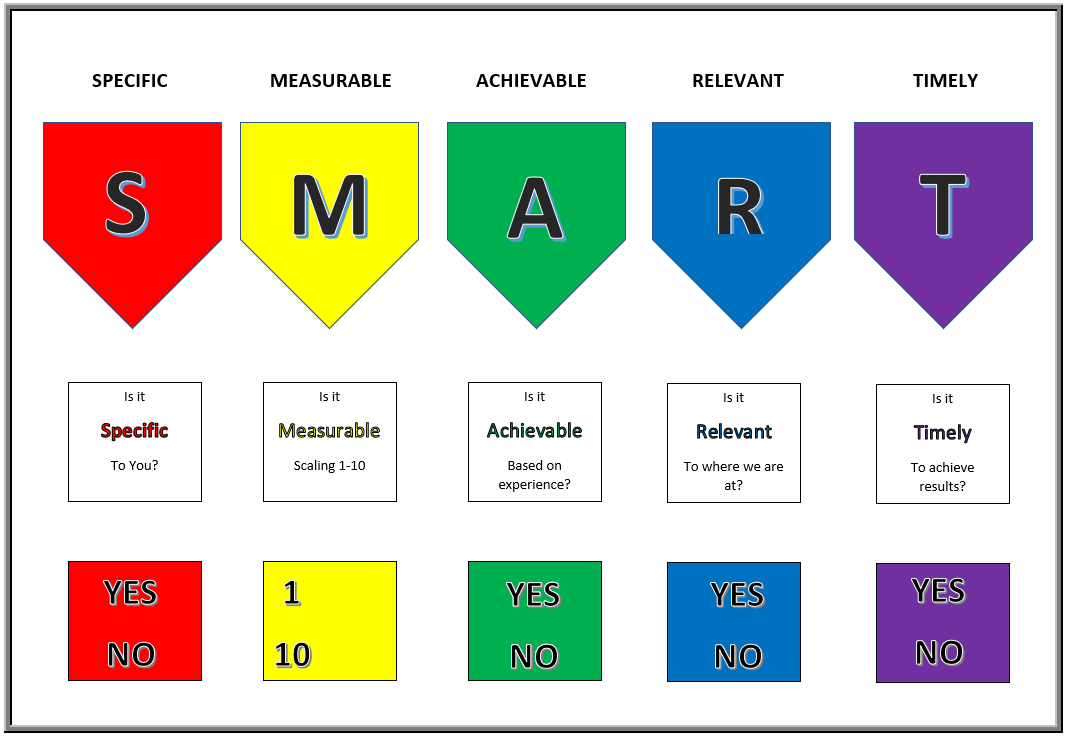
Again, as with the GROW method, the SMART method makes use of a word that will make sense to your pupil, especially when used a few times.
Is the thing you are working on SPECIFIC to your pupil?
Could you currently scale that thing from 1 -10, to be able to see if progress gets made later into your lesson.
Is what you are trying to help your pupil with achievable?
Are their current skills suitable to even consider trying to achieve it?
Would doing it at this particular time be relevant to your pupil in their learning program?
And is it achievable in the time you currently have or will this need to be carried over a few sessions?
Be honest with your pupil and don't butter things up. Let them understand how good or bad they are doing. Don't tell them that was great if it wasn't, this will only lead to a level of mistrust and an unfounded level of their current skill.
It will come back and bite you if you keep telling your pupil they are great and nearly ready for their test, when you turn around and tell them you are not taking them to test because they are not ready and they still need another 20 hours of training!

Start with the problem.
Write that problem down on a piece of paper.
Now create sub items that are going to potentially get in the way of rectifying that problem.
Then find a way around how you can alleviate those sub items to resolve your problem.
It may always be a case that there are more than one item that is getting in the way of resolving an issue.
Break them down one by one and you'll eventually resolve your problem.
Mind maps are an excellent way of finding out that there is more to your learners lack of understanding or competence in their skill than you might think there is.
There could be a multitude of things getting in their way and causing them anxieties.
There must be literally hundreds of different methods to help people learn.
Irrelevant of what ones you use, try adapting them if the one you are using is not working.
Every pupil you teach will learn differently. what works for one may definitely not work for the next.
How people learn best is by you asking them first.
Some may not have a clue how they learn best, but others may find particular ways are easier than others.
If your pupil does not know or is unsure, it will be your job to work out what works best for them.
Generally, there are 4 type of learning.
Most will have a combination of these 4 styles but more often than not they will have a predominant style of learning
Visual
Auditory
Reading & writing
Kinaesthetic
Commonly referred to as the VARK Model
Visual learners.
Prefer to take in information using charts, maps, graphs, diagrams, and more. Using images to explain concepts and ideas is the best way to reach a visual learner. However, this type of learning style does not include photographs or videos. Instead, visual learners learn best when information is presented using patterns, shapes, and other visual aids in the place of written or spoken words. One way teachers can differentiate their instruction for visual learners is by using graphic organizers to teach a lesson. A flow chart might be used to explain a scientific process, for example.
Auditory learners.
This learning style describes students who learn best when information is heard or spoken. They benefit from lectures, group discussion, and other strategies that involve talking things through. “Often people with this preference want to sort things out by speaking first, rather than sorting out their ideas and then speaking,” VARK Learn Limited explains. To help auditory learners learn, teachers can post audio recordings of lessons on the class website, or incorporate group activities that require students to explain concepts to their classmates.
Reading & writing learners.
Learners who have a reading/writing preference prefer information to be presented using words. They love to read and perform well on written assignments such as stories or book reports. “This preference emphasizes text-based input and output – reading and writing in all of its forms,” VARK Learn Limited notes. A great way to help these students learn is by having them describe diagrams or charts using written statements. Then, they can study their notes later to better retain the information.
Kinaesthetic learners.
Kinaesthetic learners learn best when they can use tactile experiences and carry out a physical activity to practice applying new information. “People who prefer this mode are connected to reality, ‘either through concrete personal experiences, examples, practice or simulation.
Give these students a working example of an idea or process, or task them with recreating experiments to illustrate concepts. Sometimes this is just a case of trial and error to find out what works and what doesn't.
Ensuring you give a client centered lesson should mean that you are making the lesson around your pupils needs and this should incorporate how they prefer to learn.
Adapting your teaching style to suit your pupils may take a little time but once you have found what works best for them you will tend to stick with it, but always be prepared to adapt that style if it is necessary.
On your first lesson with your pupil and in an attempt to start building a rapport with your pupil, you may ask them what their hobbies and interests are, based on their response and by your own intuition you may be able to gauge from this how they might learn best.
In my time as an instructor I have found that those who have good motor skills tend to learn quicker.
Those who have hobbies or interests that involve using their hands in a technical manner such as playing a guitar, drums, or are a tradesperson also tend to be quick learners.
This is because they have skills to multitask and link things together.
If you find that the manner in which you are delivering the lesson is making no difference to the outcome of the task in hand, then the teaching style you are using is probably not working and will require you to try something different.
This may mean offering a demonstration, using visual aids, dry wipe board, a video, of whatever other tools you may have to hand to assist your pupil.
How will I know if I've got it right?
If learning is taking place with relative ease, it is highly likely that you've got it right.
If you are trying something again and again (your preferred teaching style) and there appears to be no change in the outcome, then it's highly likely you're not on the right path for that particular pupil, and you will need to adapt.
Try and understand that your learner will have a preferred learning style which you need to find, but also remember you will probably have a preferred teaching style. Getting in a rut and using that same style of teaching for each pupil will not be beneficial to your pupil if learning is not taking place.
If you are becoming totally stumped after trying different methods, or even after a couple of attempts, you can always ask your pupil various questions.
"How can I help you to achieve your goal"
"Is there something I can do to help make things clearer for you?"
"Would watching a quick video on the subject help you?"
"Would me giving you a demonstration help?"
It's amazing how your pupil will open up to you if you offer help and they are struggling!
If you don't offer the assistance they may feel too embarrassed to ask.
By asking them this will also help with them building a trust with you, that they know you understand them and won't hesitate in the future to ask for your help if they aren't quite getting it.
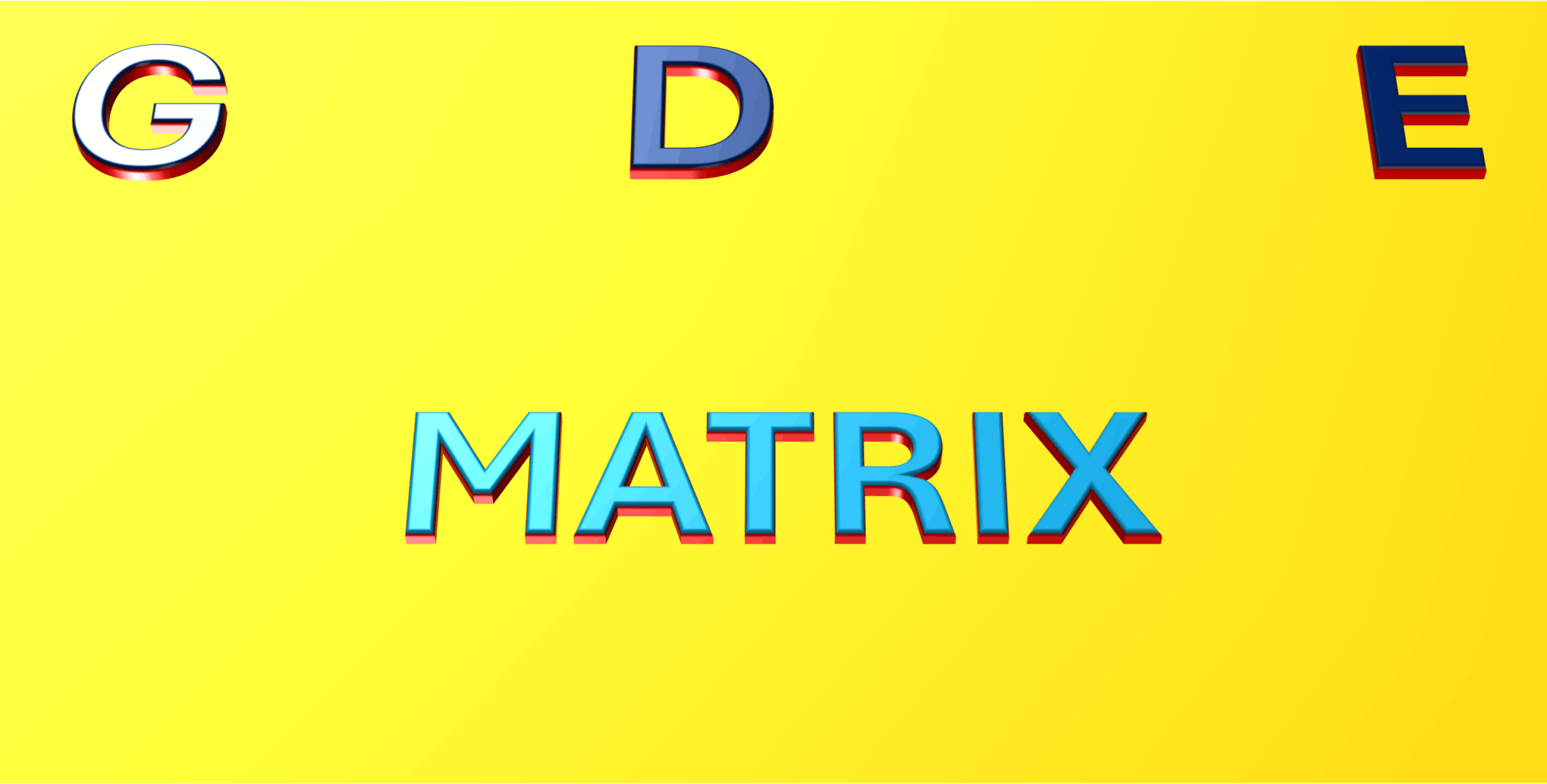
Vehicle control x 3 levels
Driving in Traffic x 3 levels
Goals and context of Driving x 3 levels
Goals for life and skills for living x 3 levels
Knowledge and skills
Risk increasing Factors
Self Evaluation
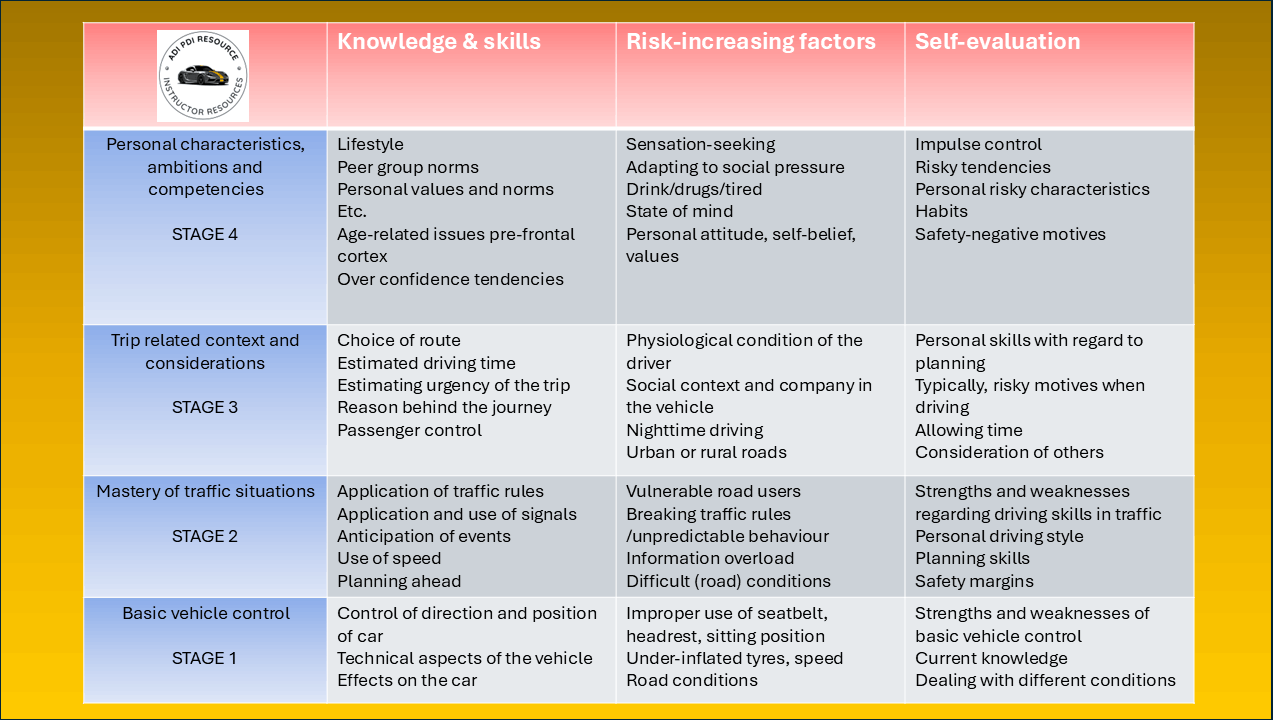
Hatakka, Keskinen, Glad, Gregersen, Hernetkoski, 2002
Now understands the skill better but are still not very good at achieving it.
At this stage understands the skill, but still needs to mentally think about it while carrying it out.
Understands the skill fully and can carry it out without thinking about it.

There is a known analogy within the training industry as well as other industries that goes:
"You can't eat an elephant in one go, but you'll get there by taking a bite sized chunk at a time"
If you relate that to dealing with bite sized chunks of information to your pupil and allow them to digest it, you can them move on to the next chunk.
If you try eating all the information at once, you won't manage it!